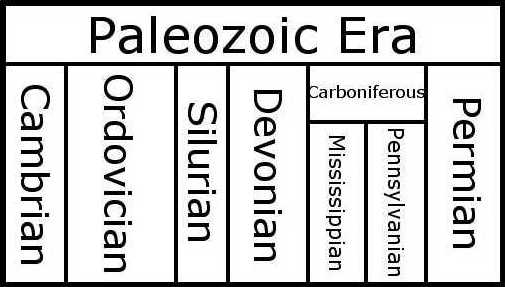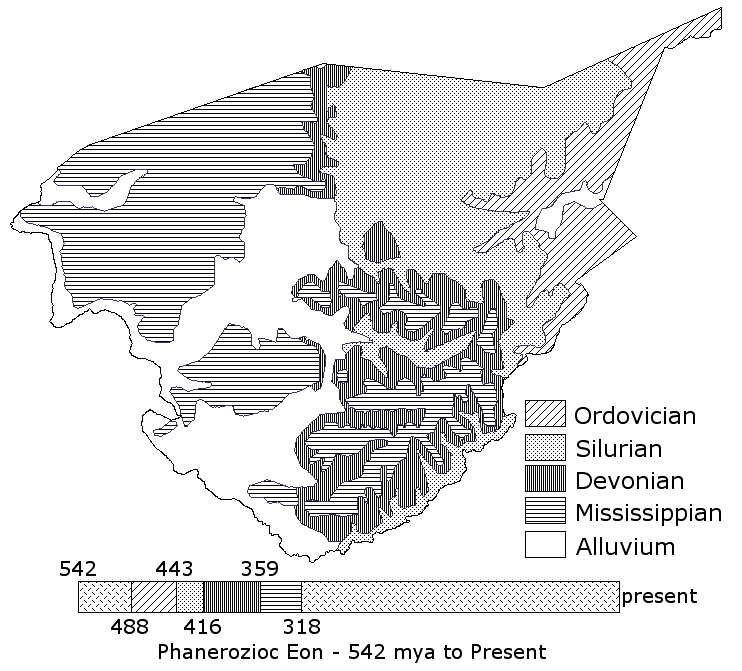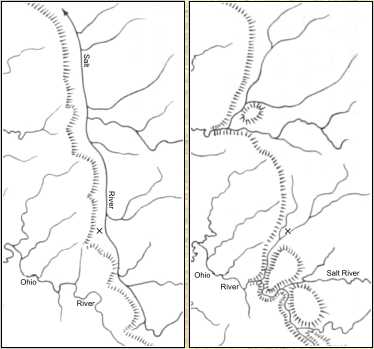
With the vast wilderness before them, what was it that brought the first pioneers to this place we call Bullitt County today? To answer this question, we need to look back to a time long before mankind walked this land, a time when warm shallow seas covered what was to become Kentucky.
Here is a link to a "Bullitt Memories" article related to this topic that you might find interesting.
For geologists, the history of the earth is separated into divisions to describe geologic time. The period of time that interests us here is called the Phanerozoic Eon which geologists indicate began about 542 mya (mya = "million years ago"). That eon is divided into three era: Paleozoic (542-248 mya), Mesozoic (248-65 mya), and Cenozoic (65 mya to present). We are most interested in the Paloezoic Era for it was during this time that the rock formations that affect the topography of Bullitt County were established.

The Paleozoic era is subdivided into six geologic periods as shown in the chart to the right. We are first interested in the Ordovician Period.
During the Ordovician Period (488-443 mya), the area north of the tropics was mostly ocean. Most of the world's land was collected into a southern super-continent geologists call Gondwana, a name derived from the ancient Gond tribe of India. In the early Ordovician, what would become North America lay roughly along the equator and almost all of it lay under warm shallow seas which encouraged the growth of organisms that deposit calcium carbonates in their shells and hard parts. These seas deposited sediments under conditions similar to those in tropic areas today.
Ordovician rocks are chiefly sedimentary and contain abundant fossils. Because of the restricted area and low elevation of solid land, which set limits to erosion, marine sediments that make up a large part of the Ordovician system consist chiefly of limestone. Shale and sandstone are less conspicuous. During this period the rock that is now the surface rock of the Bluegrass region of Kentucky was laid down. This includes part of eastern Bullitt County today as shown on the map below.

The Ordovician ended with a drop in sea level brought on by the cooling of the planet. As the southern supercontinent Gondwana drifted over the South Pole, ice caps formed on it, adding to the growth of glaciers. This drop in sea level left more land in what would become North America exposed to wind erosion. As glaciers grew, they locked up more water from the ocean during this era.
The Silurian (approximately 443-416 mya), saw a return of very warm tropical seas with limy sediments that were deposited on the seafloor. These deposits form the surface rock that is exposed on the outer edge of much of the Bluegrass region, especially here in Bullitt County.
The continued drift of the earth's tectonic plates resulted in a gradual breakup of the massive supercontinent, Gondwana, as well as the drifting of land masses away from the polar region. The world's general climate became relatively stable. With the melting of large glacial formations, the period saw a significant rise in the levels of the major seas, creating many new marine habitats.
Although there was little major volcanic activity during the Silurian, there were major mountain-building events in eastern North America which would indirectly influence land building here.
The surface rock that forms much of the central part of Bullitt County today was laid down during the Devonian Period (approximately 416-359 mya). Warm tropical seas continued to cover Kentucky during this era and marine fossils from this time are quite varied. Near the end of the Devonian water flow was reduced, resulting in oxygen depletion near the sea floor. This prevented the decay of plant and animal remains, and organic-rich shales were deposited on the seafloor.
Among the carbonate sediments deposited on the shallow sea floor were other elements, dissolved solids including sodium-chloride—salt. These elements were eroded from the earth's land masses and deposited in the sea in runoff, as well as ejected from undersea volcanoes.
Geologic forces from within the earth very slowly uplifted the shallow sea floor, slowing the flow and currents which resulted in deposits of precipitated solids, including salt. Then the uplifting stalled and warm seas rose once more leading to additional deposits of carbonic sediments. This process repeated itself numerous times, resulting in multiple layers of sediment. The weight of each new layer pressed down on those below it, resulting in the rock layers we see exposed today.
The Mississippian Period (approximately 359-318 mya) continued this process of sediment layering. Along its northern edge lies the summit of Muldraughs Hill, a prominent escarpment that separates the Mississippian Plateau from the Outer Bluegrass region. Surface rock in this area is dominated by limestones, sandstones, and some shales.
Along the edge of this escarpment lies a ten-to-fifteen mile wide region which contains erosional remnants that developed where resistant caprocks of sandstone and limestone overlaid easily eroded shale and siltstone. With the passage of time, drainage systems cut through the softer rocks, leaving behind the rounded mounds that today we call the Knobs. The sharp slopes of the Knobs are mostly composed of shales which are less resistant to erosion than the overlying limestones and sandstones.


View of knobs and Muldraugh's Hill escarpment in the distance;
taken from near summit of MacDonald Knob north of Shepherdsville.

The westward stream flow from the uplifted Bluegrass, and the northeastward flow from the eroded Muldraughs Hill escarpment, combined together to form the flood plains that surround our streams today. These stream beds, which had been deeply dug by the rapid flow of runoff in more active geologic times, were gradually filled with the sediment left behind by slower moving streams.
Geologists tell us that the Salt River is an ancient river that once flowed northward along the boundary between the Outer Bluegrass and the Mississippian escarpment of which Muldraughs Hill is the southern portion. At that time the Ohio River existed only on the western side of this escarpment as shown on the left map. The X on both maps shows the present location of Louisville.
The relief between these two regions was relatively low, but sufficient to separate the two drainage basins. At this time the Knobs were probably still attached to the upland along the crest of the Muldraughs Hill escarpment, making the escarpment continuous.
During the succeeding millennia, episodes of uplift and erosion allowed tributaries of the Ohio River to erode notches in the escarpment and capture or divert parts of the drainage of the formerly north-flowing Salt River, as shown in the map on the right. This occurred prior to the Pleistocene Epoch.
During the Pleistocene Epoch (approximately 1.8 million to 11,550 years ago) the continents reached their approximate present locations, and during this time glacial ice sheets covered much of North America and extended southward to just north of the present position of the Ohio River.
During parts of this time, streams, such as the ancient Salt River, that had drained northward were ponded by the ice front, creating lakes that rose over the lowest divides and began to spill into the next basin. As the glaciers melted and receded the meltwater added to the flow resulting in the establishment of a new channel that connected Salt River with the Ohio River, diverting the waters westward.
During the waning phases of the last Ice Age, meltwater deposited most of the clay and silt sediments now present in the valley of the Salt River and its tributaries.
Salt River and its tributary, Floyd's Fork, flow out of the Outer Bluegrass. Downstream from Shepherdsville, Salt River flows through a tapering notch in the Knobs into a broad, flat valley with the Rolling Fork joining it where Pitts Point once stood. The river then parallels the east slope of Muldraughs Hill, cutting its way through the Knobs until it reaches the Ohio River. It is along the stretch between Floyd's Fork and Rolling Fork that the early pioneers came. What brought them here had been deposited in the ground long ago—salt.
Since salt dissolves in water, rising ground water levels turned the solid salt formations into a thick saline solution and forced it upward into cracks and crevices. When the ground water levels reached the surface in the form of springs, water which had passed through a underground layer of salt brought the salty water to the surface.
When the level of ground water began to very slowly sink, the salt precipitated and was left behind. At the surface this left what is commonly called a salt lick because animals will come to it and lick the salt from the ground. As the ground water sank even further, it left behind salt-impregnated clays. Thus a salt layer laid deep below the surface can, with the assistance of rising and falling ground water levels, reach the surface or near it to be exploited.
Taking a Sunday Drive is a "Bullitt Memories" article related to this topic that you might find interesting.
Here is a link to it.
This is a work in progress. It is copyright 2011 by Charles Hartley, Shepherdsville KY. All rights are reserved. No part of the content of this page may be included in any format in any place without the written permission of the copyright holder.
Significant parts of this work are inspired by Geology of the Falls of the Ohio River by Richard L. Powell which is Indiana Geological Survey Circular 10, published by Indiana University. Follow this link to their site to purchase this book. If it fails, then go to their bookstore. Then use the search box on the bookstore page and do a title search for "Falls of the Ohio." This book should come up at or near the top of the list.
If you, the reader, have an interest in any particular part of our county history, and wish to contribute to this effort, use the form on our Contact Us page to send us your comments about this, or any Bullitt County History page. We welcome your comments and suggestions. If you feel that we have misspoken at any point, please feel free to point this out to us.
The Bullitt County History Museum, a service of the Bullitt County Genealogical Society, is located in the county courthouse at 300 South Buckman Street (Highway 61) in Shepherdsville, Kentucky. The museum, along with its research room, is open 10 a.m. to 4 p.m. Monday through Friday. Saturday appointments are available by calling 502-921-0161 during our regular weekday hours. Admission is free. The museum, as part of the Bullitt County Genealogical Society, is a 501(c)3 tax exempt organization and is classified as a 509(a)2 public charity. Contributions and bequests are deductible under section 2055, 2106, or 2522 of the Internal Revenue Code. Page last modified: 12 Sep 2024 . Page URL: bullittcountyhistory.org/bchistory/theland.html